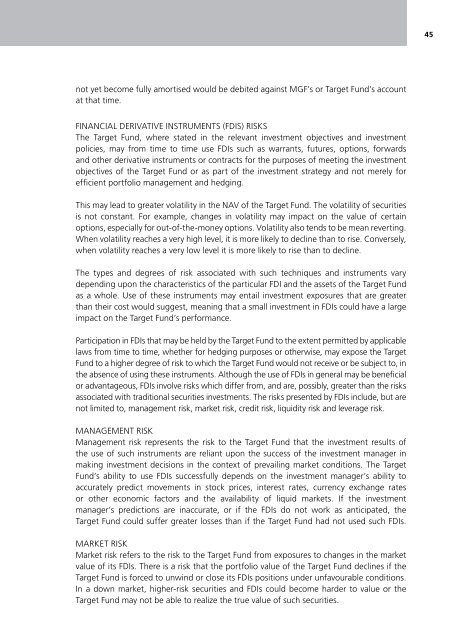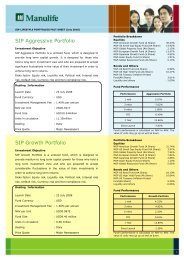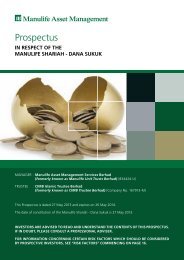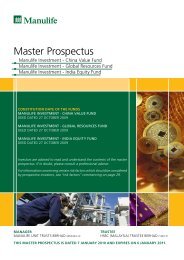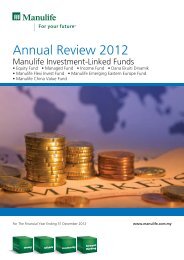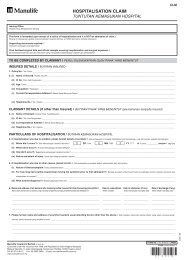trustworthy - Manulife Insurance Berhad
trustworthy - Manulife Insurance Berhad
trustworthy - Manulife Insurance Berhad
Create successful ePaper yourself
Turn your PDF publications into a flip-book with our unique Google optimized e-Paper software.
45<br />
not yet become fully amortised would be debited against MGF’s or Target Fund’s account<br />
at that time.<br />
Financial Derivative Instruments (FDIs) Risks<br />
The Target Fund, where stated in the relevant investment objectives and investment<br />
policies, may from time to time use FDIs such as warrants, futures, options, forwards<br />
and other derivative instruments or contracts for the purposes of meeting the investment<br />
objectives of the Target Fund or as part of the investment strategy and not merely for<br />
efficient portfolio management and hedging.<br />
This may lead to greater volatility in the NAV of the Target Fund. The volatility of securities<br />
is not constant. For example, changes in volatility may impact on the value of certain<br />
options, especially for out-of-the-money options. Volatility also tends to be mean reverting.<br />
When volatility reaches a very high level, it is more likely to decline than to rise. Conversely,<br />
when volatility reaches a very low level it is more likely to rise than to decline.<br />
The types and degrees of risk associated with such techniques and instruments vary<br />
depending upon the characteristics of the particular FDI and the assets of the Target Fund<br />
as a whole. Use of these instruments may entail investment exposures that are greater<br />
than their cost would suggest, meaning that a small investment in FDIs could have a large<br />
impact on the Target Fund’s performance.<br />
Participation in FDIs that may be held by the Target Fund to the extent permitted by applicable<br />
laws from time to time, whether for hedging purposes or otherwise, may expose the Target<br />
Fund to a higher degree of risk to which the Target Fund would not receive or be subject to, in<br />
the absence of using these instruments. Although the use of FDIs in general may be beneficial<br />
or advantageous, FDIs involve risks which differ from, and are, possibly, greater than the risks<br />
associated with traditional securities investments. The risks presented by FDIs include, but are<br />
not limited to, management risk, market risk, credit risk, liquidity risk and leverage risk.<br />
Management Risk<br />
Management risk represents the risk to the Target Fund that the investment results of<br />
the use of such instruments are reliant upon the success of the investment manager in<br />
making investment decisions in the context of prevailing market conditions. The Target<br />
Fund’s ability to use FDIs successfully depends on the investment manager’s ability to<br />
accurately predict movements in stock prices, interest rates, currency exchange rates<br />
or other economic factors and the availability of liquid markets. If the investment<br />
manager’s predictions are inaccurate, or if the FDIs do not work as anticipated, the<br />
Target Fund could suffer greater losses than if the Target Fund had not used such FDIs.<br />
Market Risk<br />
Market risk refers to the risk to the Target Fund from exposures to changes in the market<br />
value of its FDIs. There is a risk that the portfolio value of the Target Fund declines if the<br />
Target Fund is forced to unwind or close its FDIs positions under unfavourable conditions.<br />
In a down market, higher-risk securities and FDIs could become harder to value or the<br />
Target Fund may not be able to realize the true value of such securities.


